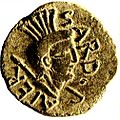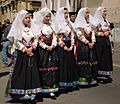Sardinians facts for kids
| Total population | |
|---|---|
| 1.5 million (est.) | |
| Languages | |
| Sardinian, Italian, Corsican, Catalan | |
| Religion | |
| Christianity | |
| Related ethnic groups | |
| Neolithic European farmers Corsicans, Spaniards and Italians |
The Sardinians are the people who come from the island of Sardinia. This island is a special region of Italy. Sardinians have a very long and interesting history.
They are famous for an ancient civilization called the Nuragic civilization. This civilization built amazing stone towers and villages. Many Sardinians also speak their own special language, called Sardinian. This language is quite different from Italian. It is known for keeping many old features from ancient Latin. Sardinians have worked hard to get their culture and island protected. They also want their region to have more self-rule within Italy.
Contents
Who are the Sardinians?
Sardinians are the native people of Sardinia. This beautiful island is located in the Mediterranean Sea. It is part of Italy, but it has a unique identity. About 1.5 million Sardinians live on the island today. Many more live in other parts of Italy and around the world.
A Look at Ancient Sardinia
Sardinia has been home to people for thousands of years.
The Nuragic Civilization
One of the most exciting parts of Sardinian history is the Nuragic civilization. This culture existed from about 1800 BC to 200 BC. They built special stone towers called nuraghi (say: noo-RAH-gee). There are thousands of these towers all over the island. No one knows exactly why they built them. They might have been homes, forts, or even temples.
- The Nuragic people were skilled builders.
- They also made beautiful bronze statues.
- These statues showed warriors, animals, and everyday life.
- The Nuragic civilization was very advanced for its time.
Other Ancient Visitors
Over the centuries, many different groups came to Sardinia.
- The Phoenicians were traders from the Middle East. They set up trading posts along the coast.
- Later, the Carthaginians took control of parts of the island. They were a powerful empire from North Africa.
- Finally, the Romans conquered Sardinia. They ruled the island for many hundreds of years. They brought their language, Latin, which later influenced Sardinian.
The Sardinian Language
The Sardinian language is very special. It is one of the oldest Romance languages. This means it comes from Latin. But it kept many old Latin sounds and words. This makes it sound different from Italian.
- There are different dialects of Sardinian.
- These dialects are spoken in different parts of the island.
- Many young people are learning Sardinian again.
- This helps keep the language alive.
Sardinian Culture and Traditions
Sardinia has a rich and vibrant culture. It is full of unique traditions.
Music and Dance
Music is a big part of Sardinian life.
- The launeddas is an ancient wind instrument. It has three pipes and makes a unique sound.
- Traditional songs often tell stories of the island's history.
- Folk dances are performed at festivals. People wear colorful traditional clothes.
Food and Festivals
Sardinian food is delicious and often uses local ingredients.
- Pane carasau is a very thin, crispy flatbread. It has been eaten for thousands of years.
- Cheese from sheep and goats is very popular.
- Sardinians celebrate many festivals. These often include parades, music, and traditional costumes.
- The Sa Sartiglia in Oristano is a famous medieval horse race.
Traditional Clothing
Sardinian traditional clothes are very beautiful. Each village often has its own unique style.
- Women's costumes are often colorful. They have embroidered details and special head coverings.
- Men's costumes might include dark trousers, white shirts, and vests.
- These clothes are worn during festivals and special events.
Related pages
Images for kids
-
Megalithic altar of Monte d'Accoddi, built by ancient Sardinians.
-
Map showing areas controlled by Carthage in Sardinia.
-
Historic cemetery of Ploaghe with tombstones in Sardinian.
-
Pane carasau, a traditional Sardinian flatbread.
-
Children from Ovodda in traditional dress.
-
An Urthos mask from Fonni.
-
Traditional robes from Maracalagonis.
-
A woman from Ollolai in traditional dress.
-
Traditional robes from Cagliari.
-
Traditional robes from Busachi.
-
Traditional robes from Olbia.
-
Traditional robe from Sennori.
-
Daily traditional clothes from Dorgali.
-
Folk robes from Quartu Sant'Elena.
-
Traditional robes from Selargius.
-
Traditional robes from Assemini.
-
A child from Aritzo in traditional dress.
-
Women dressed in traditional Sardinian clothing (Quartucciu).
-
Traditional robes from Settimo San Pietro.
-
Traditional robe from Dolianova.
-
Men from Lanusei in traditional dress.
-
Traditional robe from Nuragus.
-
Traditional robe from Bultei.
-
Children from Villanova Monteleone in traditional dress.
-
Knights from Teulada.
-
Traditional robe from Laconi.
-
Traditional robe from Tonara.
-
Traditional robes from Fonni.
-
A Mamuthone and an Issohadore, traditional carnival masks from Mamoiada.
-
Sardinian knights at the Sa Sartiglia festival in Oristano.
-
People in traditional dress from Busachi.
-
Traditional robe from Orgosolo.
-
Sardinian men and children in traditional dress at the Sagra del Redentore in Nuoro.
-
Children from Ovodda in traditional dress.
-
An Issohadore, a typical mask of the Sardinian carnival from Mamoiada.
-
A Mamuthone, another typical mask of the Sardinian carnival from Mamoiada.
-
Boe and Merdule masks from Ottana.
-
Sardinians in traditional dress from Orgosolo.
-
Traditional robe from Atzara.
-
Traditional robe from Oliena.
-
Traditional robe from Orune.
-
A man from Austis in traditional dress.
-
Traditional robe from Ittiri.
-
A woman from Fonni in traditional dress.
-
Traditional robe from Sassari.
-
Traditional robe from Cossoine.
-
Traditional robe from Isili.
See also
 In Spanish: Pueblo sardo para niños
In Spanish: Pueblo sardo para niños
































































